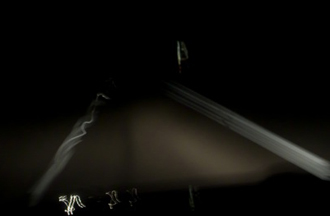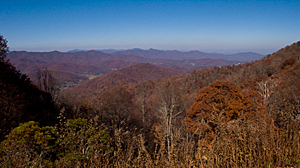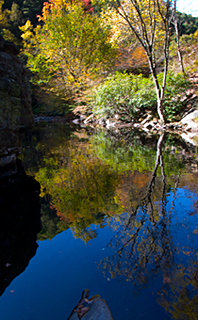Elkmont and the Great Smoky Mountains
The road undulates through the darkness, over the long, arching tails of mountain ridges, where the eastern slopes of the Smokies taper off into the Tennessee River Valley. Divets between tiny the rolling hilltops form eerie microclimes of misty white clouds hugging the valleys and road like the fingers of some wispy white mountain ghosts snaking down from the peaks.
 With the windows cracked it’s not hard to tell that the pockets of fog gather in the cold crevasses where the temperature drops noticeably along with the highway. From the top of every small hill, the headlights move like shiny ribbons though the knuckles of mountains. As the beams dive back down, the view from behind the windshield becomes a bath of smoky white light — a film noir scene brought to life. And then the car rushes up out of the chilly depths and into the clear night, atop another ridge where the remnants of wood plank fences line the road.
With the windows cracked it’s not hard to tell that the pockets of fog gather in the cold crevasses where the temperature drops noticeably along with the highway. From the top of every small hill, the headlights move like shiny ribbons though the knuckles of mountains. As the beams dive back down, the view from behind the windshield becomes a bath of smoky white light — a film noir scene brought to life. And then the car rushes up out of the chilly depths and into the clear night, atop another ridge where the remnants of wood plank fences line the road.
From a particularly high ridge the land is lit up by the rising moon and succession of foggy pockets and lumpy ridges between spreads out like cigarette smoke settling in the creases of some red vinyl cushions, tucked in the corner of an all night diner, straight out of the 1950s.
The Smoky Mountains are, as it turns out, well named.
Were it light, the landscape and buildings in the area would indeed look much like the 50s. Not a lot appears to have changed on the slopes of the Smokies in quite some time. The new developments — strip malls, cookie cutter suburbs and giant megastores — are further up ahead, around the bend in Knoxville, Maryville.
But out here in the boundary land of mountain and plain it’s just the headlights stabbing through the fog.
I keep half expecting to see some ghostly figure off in the shadowy outline of trees at the edge of the small arc of headlamps, to catch some otherworldly creature slouching through the foggy forest, off to haunt the crumbling farm houses set back from the road, enveloped in night.
Occasionally I pass through a town — sudden, brilliant, florescent — gas stations, neon beer signs in a window, telephone wires, stoplights, downshifting and then fading in the rearview mirror, returning to the murky hills.
It continues like that with a brief break through Maryville where Starbucks and shopping malls remind me that I am indeed still part of the 21st century. But then that fades as we move into the mountains again, higher, this time in pure blackness, even the fog is gone.
 After a while the zigzags stop and the road follows the river upstream headed to Pigeon Forge, which, when you reach it in darkness, can’t help but look like an amusement park at the gates of hell, a last ditch effort of all failed American cultural ideas shored up together — Elvis impersonators, mini golf, Dollyworld, all-you-can-eat restaurants serving every food imaginable as long as your imagination is limited to steak and pizza, which apparently, for many, it is.
After a while the zigzags stop and the road follows the river upstream headed to Pigeon Forge, which, when you reach it in darkness, can’t help but look like an amusement park at the gates of hell, a last ditch effort of all failed American cultural ideas shored up together — Elvis impersonators, mini golf, Dollyworld, all-you-can-eat restaurants serving every food imaginable as long as your imagination is limited to steak and pizza, which apparently, for many, it is.
Pigeon Forge is everything that’s wrong with America.
Pigeon Forge is Myrtle Beach in the mountains, it lacks any basis in reality and, like Myrtle Beach, it doesn’t really exist. It’s all just redneck weddings cascading straight out of the chapel and into the mini golf reception area.
I used to think the demise of such places would be gradual, almost imperceptible, until one day they were just vacant and ghostly, joining Bowie CA, Bisbee, St Elmo and other places that simply slipped our collective minds. However, in the case of Pigeon Forge it may well be much faster. The people who come here are the same ones now mailing their house keys to the mortgage companies — the unreality of it all only lasts for so long. Of course I could be wrong.
And we aren’t here for Pigeon Forge, it just happens to have a free condo we’re staying in. We’re here for the mountains. Smoky Mountain National Park is just a few miles up the road.
The next morning I’m sitting on the patio, bundled up against the unseasonable cold, reading Cormac McCarthy’s The Orchard Keeper which is largely set here in these same mountains, but back in the early 1920s. The Orchard Keeper is fiction, but McCarthy spent a fair share of his life in Sevier County and knew these mountains well — you can feel them living and breathing right there in the turning of the page.
He came out on a high bald knoll that looked over the valley and he stopped here and studied it as a man might cresting a hill and seeing a strange landscape for the first time. Pine and cedars in a dark swath of green piled down the mountain to the left and ceased again where the road cut through. Beyond that a field and a log hogpin, the shakes spilling down the broken roof, looking like some diminutive settler’s cabin in ruins. Through the leaves of the hardwoods he could see the zinc-colored roof of the church faintly coruscant and patched of boarded siding weathered the paper-gray of a waspnest. And in the distance the long purple welts of the Great Smokies.
 Although with a bit of driving, and some selective horizon framing, you can find crumbling buildings with collapsing siding that does indeed resemble the “paper-gray of a waspnest,” or the ridgelines like bruised knuckles interrupting the sunrise, for the most part McCarthy’s vision of the Smokies is just a memory, a half crumbled placemarker at a neglected turnout in the road, a few yellowed, slightly retouched photos in a visitor center, a coffee table book of history purchased for friends back home.
Although with a bit of driving, and some selective horizon framing, you can find crumbling buildings with collapsing siding that does indeed resemble the “paper-gray of a waspnest,” or the ridgelines like bruised knuckles interrupting the sunrise, for the most part McCarthy’s vision of the Smokies is just a memory, a half crumbled placemarker at a neglected turnout in the road, a few yellowed, slightly retouched photos in a visitor center, a coffee table book of history purchased for friends back home.
I would love to know what McCarthy thinks of Sevier and environs now. It would be nice to drink a pint with him and hear about a time when men and women were sane, cautious and respectful. Of course, if you’ve ever read a McCarthy book you know what happens to those characters, they are, in one way or another displaced by the less savory, the more ambitious, more full of hot air and power-hungry dreams.
In McCarthy’s world the meek very rarely inherit anything save dust and silence, but they do retain their dignity, something painfully lacking in Pigeon Forge.
 The mountains are still beautiful, dying perhaps, choking on smoke from Chattanooga and Atlanta, mostly Atlanta, but in the mean time the leaves on the trees run the spectrum from ochre to vermillion with all the middle hues as well.
The mountains are still beautiful, dying perhaps, choking on smoke from Chattanooga and Atlanta, mostly Atlanta, but in the mean time the leaves on the trees run the spectrum from ochre to vermillion with all the middle hues as well.
We spend a few days, driving mainly, but occasionally walking, through the mountains, the trees, along the rivers and streams, the windswept peaks with fog breaking over them like waves of mist and smoke.
There are also the crumbling remains of old grist mills and early towns now abandoned; remnants of a time, near the end of the 19th century when hiking and exploring the outdoors was all the rage — John Muir helped the trend along, but for a time people genuinely liked to get up into the mountains, out in the desert and see America’s unparalleled natural wonderland.
One the byproducts of that era is the ghost town of Elkmont, lying under the steep ridges of the Smokies at the end of railway line that used to stretch back to down to Maryville. Elkmont began like as a rough and tumble logging town, and while I couldn’t find mention of it in The Orchard Keeper, it dates from 1908 which puts it in roughly the same time frame.
Over time Elkmont ran out of trees to easily harvest and the town gradually evolved into a haven for the socially prominent and wealthy members of Knoxville, Maryville, and Chattanooga — summer cottages were built, a central hunting lodge was added and members built a number of trails that lead off into the Smokies.
At the zenith of its popularity the Little River Railroad, which ran from Knoxville to Elkmont, offered a Sunday “Elkmont Special” — non-stop train service to the mountains. That proved popular enough that the Sunday special became a regular, several days a week route.
Then that passed or was diluted somehow, getting out to see the land was condensed down to the somewhat easier, more profitable habit of just buying fleece jackets at the mega-mall and playing a bit of putt-putt golf in Pigeon Forge.
Oh well.
One piece of advice, should you head to Smoky Mountain National Park, don’t dig too deep, if you do any more than scratch the surface you might discover some unpleasant things — like the signs along the river that read: Do Not Drink, Swim, Bathe or Touch the Water; River contains fecal matter.
Yes, the rivers are full of shit. Shouldn’t be surprising then that Pigeon Forge is full of shit. Everything trickles downhill as they say.
And we are all more or less full of shit.
Don’t drink the water.
And so it goes.
2 Comments
As a young boy in the 1950’s I explored all around the tracks and old station for the Smoky Mtn Railroad. Although I was too young to ever have ridden that train, I knew several people that did ride. They all told me it was originally set up as a logging train from Elkmont to Knoxville. There was also a dam on the creek there at the bottom of the hill on Cumberland Ave close to the train station. We played on the rusting and decayed engines and walked around in the old station building. It was pretty well grown over when we found this site in about 1957-58. My best friends grandfather was former UT President James D Hoskins and they lived at 834 Temple Ave just up the street from me at 944 Temple. My friend was Billy Hoskins. His Grandmother, Mrs Wright had a cabin at Elkmont, just up the road leading out of the parking lot from the Wonderland Club Hotel along with many other cabins. I spent many weeks in that cabin in the summers of the 1950’s and early 1960’s. I loved the Wonderland Club Hotel with its big porch and rocking chairs and the nice restaurant. It seems odd that the gov’t saw fit to let all this history revert back to wilderness without so much of as a trace and to see how now the Smokies are represented to the world by Pigeon Forge and Gatlinburg.
I do miss the Elkmont of old. It truly was a beautiful and wonderful place to be as a kid. I still drive up there to see the place but the Wonderland Hotel has completely fallen in and most of the cabins are gone as well.
Oh well, that’s progress I guess !
@Kenyon-
Yeah Elkmont is stuck in a catch-22, the park service wants it gone and the land returned to its wild origins, but the historic preservation society wants it restored as a kind of museum/monument sort of thing. Strange spot to be in. Personally, while I enjoyed seeing it, and hearing stories like yours, I say let it go. Even if it’s restored, it won’t be the same. Sometimes it’s better to just let things be what they were and not try to hold them past their time.
Thoughts?
Please leave a reply:
All comments are moderated, so you won’t see it right away. And please remember Kurt Vonnegut's rule: “god damn it, you’ve got to be kind.” You can use Markdown or HTML to format your comments. The allowed tags are
<b>, <i>, <em>, <strong>, <a>. To create a new paragraph hit return twice.